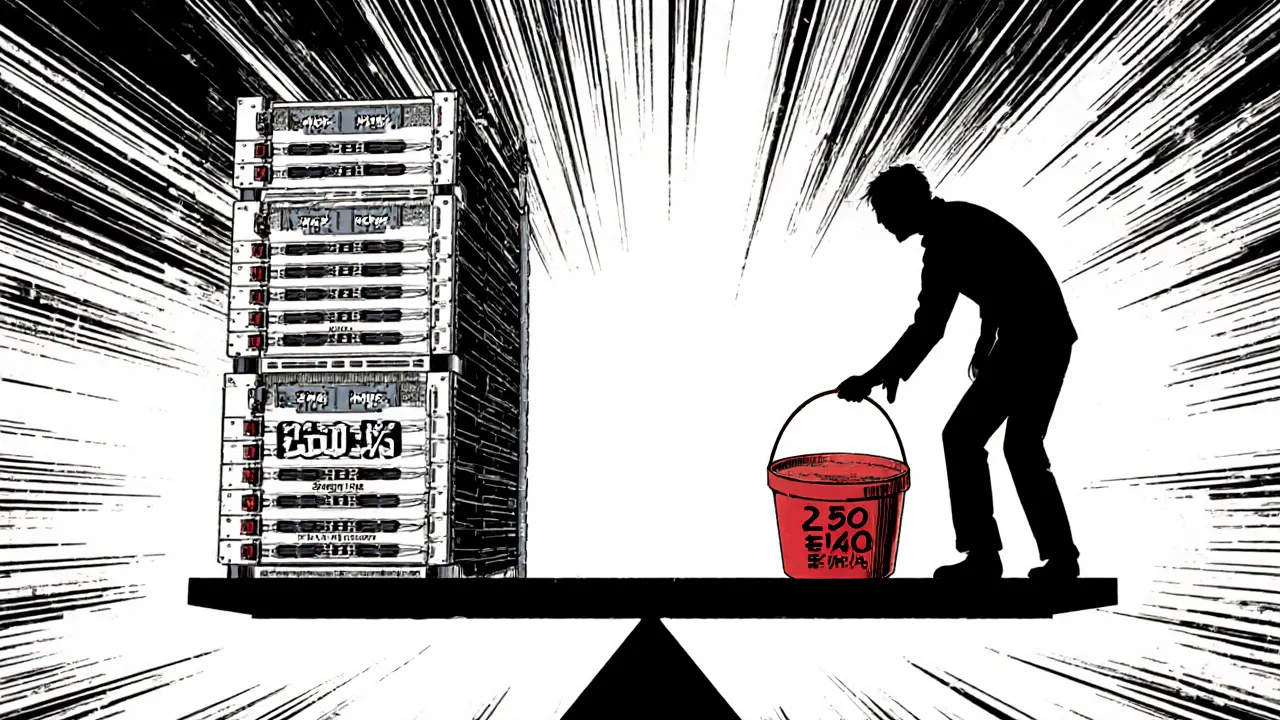Blockchain Hash Rate Security Calculator
Enter a blockchain's current hash rate (in EH/s) to calculate its approximate security level and resistance to 51% attacks.
Security Analysis Results
Compare security levels across major blockchain networks.
| Network | Hash Rate (EH/s) | Security Level |
|---|---|---|
| Bitcoin | 500+ | Very High |
| Ethereum (pre-ETH2) | 1 | High |
| Litecoin | 300 | High |
Hash Rate is the total computational power that miners collectively devote to solving cryptographic puzzles on a proof‑of‑work blockchain. It’s measured in hashes per second (H/s), with modern networks often quoted in terahashes (TH/s) or exahashes (EH/s). For example, Bitcoin’s hash rate sits above 500EH/s, meaning the network crunches more than 500 quintillion hashes every second.
Why Hash Rate Equals Security
Higher hash rates make attacks economically infeasible. A 51% attack requires an adversary to control the majority of the network’s computational power. If a network runs at 500EH/s, an attacker would need to marshal at least 250EH/s of hardware, power, and infrastructure. The cost of such an operation-often billions of dollars in ASICs and electricity-far outweighs any potential profit from rewriting transaction history.
Hash Rate and Mining Difficulty: The Feedback Loop
Proof‑of‑work blockchains keep block times steady by adjusting Mining Difficulty. When hash rate climbs because new miners join or hardware improves, the protocol raises difficulty so blocks still take roughly the same time to find. When hash rate drops-say, miners shut down due to low coin prices-the difficulty is lowered after a preset number of blocks (2,016 for Bitcoin, about two weeks). This automatic balancing ensures predictable transaction confirmation times and stable fee markets.

Comparing Hash Rate Across Major Networks
| Network | Algorithm | Current Hash Rate | Relative Security |
|---|---|---|---|
| Bitcoin | SHA‑256 | ≈500EH/s | Very High - best resistance to 51% attacks |
| Ethereum (pre‑ETH2) | Ethash (GPU‑friendly) | ≈1TH/s | High for a GPU‑based network, but far lower than Bitcoin |
| Litecoin | Scrypt | ≈300TH/s | Proportional to network size; adequate for its ecosystem |
Real‑World Impact: Market Confidence & Pricing
Investors treat hash rate spikes as a sign of growing network robustness. In early 2021, Bitcoin’s hash rate surged as miners upgraded to next‑gen ASICs, coinciding with the price rally past $60,000. Analysts at ChainUp noted that the heightened hash rate boosted institutional confidence, feeding the price surge. Conversely, sudden hash‑rate drops-often triggered by regulatory crackdowns or energy‑price hikes-can trigger short‑term anxiety, as the network becomes temporarily more vulnerable until difficulty readjusts.
Enterprise Considerations When Choosing a Blockchain
Businesses looking to settle payments or issue digital assets care deeply about security guarantees. A consistently rising hash rate signals healthy miner economics and a lower probability of a successful 51% attack. Companies should monitor the following signals:
- Long‑term hash‑rate growth trend (upward slope over months).
- Frequency and magnitude of difficulty adjustments.
- Geographic distribution of mining operations-concentration in a single jurisdiction can introduce political risk.
- Energy source mix; renewable‑powered mining can sustain hash rate while meeting ESG goals.
When a network’s hash rate plateaus or declines, it may indicate miner profitability issues, which could lead to centralization and heightened attack risk.

Future Outlook: Efficiency, Sustainability, and Regulation
Next‑generation ASICs are pushing hash‑rate per watt ratios higher, meaning the same amount of electricity yields more hashes. This efficiency boost allows miners to maintain or increase hash rate even as energy costs rise. Simultaneously, many large farms are plugging into renewable sources-hydro in Canada, solar in the American Southwest-so the environmental footprint decouples from raw hash‑rate growth.
Regulatory shifts also matter. Favorable policies in Kazakhstan and Texas have attracted hash‑rate‑rich operations, while stricter rules in China caused a temporary dip in global hash rate in 2021. Watching where miners relocate gives a proxy for future security trends.
Key Takeaways
- Hash rate is the primary metric of a proof‑of‑work blockchain’s resistance to 51% attacks.
- Difficulty adjustments keep block times steady, creating a self‑balancing system.
- Bitcoin’s >500EH/s hash rate makes it the gold standard for security.
- Enterprise users should track hash‑rate trends, difficulty changes, and miner geography before committing critical workloads.
- Efficiency gains and renewable energy are shaping the next wave of secure, sustainable mining.
Frequently Asked Questions
What exactly does "hash rate" measure?
Hash rate counts how many cryptographic hash functions a miner-or the entire network-can compute each second. It’s expressed in H/s, TH/s, or EH/s depending on the scale.
How does a higher hash rate prevent a 51% attack?
To control a majority of the network, an attacker must own more than half of the total hash power. As the overall hash rate climbs, the amount of hardware, electricity, and capital required for such dominance grows dramatically, making the attack cost‑prohibitive.
Why does mining difficulty change?
Difficulty is a self‑adjusting knob that keeps block creation time around a target (e.g., 10 minutes for Bitcoin). When hash rate rises, difficulty increases; when hash rate falls, difficulty drops. Adjustments happen every 2,016 blocks on Bitcoin.
Can a low‑hash‑rate network still be secure?
Security is relative. A small network with a low hash rate can be secure as long as the cost for an attacker to obtain >50% of that hash rate exceeds the potential gain. However, smaller networks are more vulnerable to well‑funded adversaries.
How do renewable energy sources affect hash rate?
Renewables lower the marginal cost of electricity, allowing miners to run more hardware profitably. This can sustain or raise overall hash rate without increasing carbon emissions, aligning security growth with ESG goals.


17 Responses
The correlation between hash power and economic deterrence is not merely linear; it reflects a deeper equilibrium where marginal cost escalates faster than potenial profit.
Reading this guide really opened my eyes to how intertwined mining economics and network safety truly are. It’s fascinating that a simple metric like hash rate can serve as a proxy for the overall health of a blockchain. The way difficulty adjustments self‑balance the system feels almost biological, like a living organism adapting to its environment. I also appreciate the clear sections on sustainability and renewable energy-those are topics many overlook. Overall, great job breaking down complex concepts into digestible parts for newcomers and seasoned enthusiasts alike.
Wow, the hash beast just grew monstrous!
When you look at the hash rate trends over months, you can spot where miners are reinvesting in newer ASICs. That upward slope often signals that the community has confidence in the protocol’s future. It’s also a good reminder that geographic diversity matters-if most miners are in a single region, regulatory risk spikes. Keeping an eye on energy sources can give clues about long‑term sustainability too. In short, a rising hash rate is generally a healthy sign, but always dig deeper.
Higher hash = safer network
Adding to what Taylor said, the regional split of mining power can actually act as a buffer against single‑jurisdiction interventions. For instance, if a crackdown hits Chinese farms, Canadian and US rigs often pick up the slack, keeping the overall hash rate stable.
Honestly this whole "higher hash = better" spiel is oversimplified you’re missing the fact that centralized mining pools can still dominate even with massive total power.
Love the optimism here 😊 The way you linked renewable energy to hash growth really shows a path forward for greener mining! 🌱
Hash rate is just a number until you realize most of those hashes are run on cheap electricity, which means profitability can swing wildly.
Sure, just crank up the hash rate and everything’s fine-until the next regulatory wave or a quantum computer shows up to ruin the party.
American blockchains need to keep their hash rates high to stay ahead of the competition, otherwise we’ll lose the edge.
Excellent overview! 🌟 The emphasis on ESG considerations aligns perfectly with global sustainability goals, and the detailed breakdown of difficulty adjustments provides valuable insight for both developers and investors.
While the article is thorough, one must consider hidden variables such as backdoor mining operations and undisclosed subsidies that could artificially inflate hash metrics. 🤔
From a technical standpoint, the hash rate is not merely a scalar representation of computational throughput; it encapsulates a multifaceted interplay of algorithmic intensity, thermodynamic efficiency, and macro‑economic incentives. The SHA‑256 algorithm, for instance, leverages a fixed round function that translates directly into ASIC design constraints, thereby dictating the marginal cost curve of additional hash power. When evaluating network resilience, one must integrate the concept of the “effective hash rate,” which adjusts for factors such as stale block rates and orphaned shares, providing a more realistic measure of actionable security. Moreover, the feedback loop between difficulty adjustment and hash rate is emblematic of a negative feedback control system, akin to a PID controller in engineering disciplines, ensuring that block times remain statistically invariant despite exogenous shocks to miner participation. It is also crucial to acknowledge the geopolitical dimension: mining clusters concentrated in a single jurisdiction can be subjected to policy volatility, which may precipitate abrupt hash rate fluctuations and, consequently, security anomalies. In the context of Bitcoin, the current hash rate exceeding 500 EH/s translates into a staggering economic barrier, where the capital expenditure required to attain a 51 % majority would exceed several hundred billion dollars, rendering hostile takeovers economically irrational for most actors.
Conversely, newer proof‑of‑work networks with lower hash rates present a different risk profile, wherein the cost‑benefit analysis for a potential attacker may be more favorable, especially if the network’s tokenomics incentivize short‑term profit extraction. This underscores the importance of dynamic monitoring of hash rate trends, difficulty retargeting intervals, and miner distribution maps, which collectively inform a comprehensive security posture assessment. Finally, the advent of more energy‑efficient ASICs and the migration toward renewable energy sources are poised to reshape the hash rate landscape, potentially decoupling raw computational power from environmental impact and thereby influencing future regulatory frameworks.
Could someone clarify how the hash rate growth in emerging Layer‑2 solutions compares to the mainnet figures? I’m curious if the security model scales similarly.
In pondering the essence of computational consensus, one might ask whether the abstract notion of “security” is merely a statistical convenience or a philosophical imperative for trustless systems.
Oh great another techie essay about hash rates-like we needed more of those.